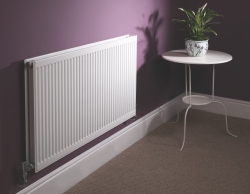Steel panel radiators respond to the times

There are many reasons why steel panel radiators continue to be effective and efficient heat emitters, explains John Colling of MARC.*
From what we have been told repeatedly over recent years, we can expect the world to be increasingly blue over the coming decades, as sea levels rise due to changes in the environment. However, the response to such threats has, in fact, been to see the world become ever greener, as legislation and behaviours adapt to counteract these ecological threats.
There is no real question, other than from conspiracy theorists, that the introduction of a more environmentally considered way of life is necessary. The heating sector has probably seen as many changes as most, alongside such industries as motoring and energy production.
The growth in technologies such as photo-voltaic panels and both ground- and air-source heat pumps as more sustainable sources of heat generation has been testament to this. Likewise, boiler manufacturers have adapted their products to be more efficient, and incentives have led to a greater number of homes being insulated to reduce their heat loss.
We have seen something of a revolution take place.
However, in the radiator market particularly, it has been a time where the gentle evolution of one of the world’s most tried-and-tested products that has allowed it to remain in a prime position for this new environmental age.
Advanced welding technologies developed by radiator manufacturers in the 1980s allow convector panels to be welded directly onto the radiator waterways. The effect of was to produce the same amount of heat output from radiators using less primary steel and water content, a major step forward in the drive for energy efficiency and carbon emissions.
Modern steel panel radiators, when fitted correctly in a well-insulated home, are as efficient a heating product as any competitor product —often, more so.
Of course, as the chairman of the Manufacturers’ Association of Radiators & Convectors (MARC), you would expect me to say that. However, the arguments are backed by scientists and industry experts from across Europe. MARC’s members also manufacture other product types, so we are not coming from a biased viewpoint.
While manufacturers of other products have, for a number of years, shouted from the rooftops about their strengths when teamed with low water temperatures, we had remained quiet, leading to widespread misconceptions that radiators were a no-go product for such applications. Indeed, it was only recently that the European Commission proposal to label heat pumps unsuitable for use with radiators was scrapped.
When the pan-European 2011 report proved to be a buster of many of the myths surrounding radiators, we had the factual ammunition to hit back.
Started by Rettig ICC’s research-and-development team, with support from a range of experts from Finland, Germany and Sweden, the report showed the following.
• Due to their flexibility, steel panel radiators and convectors are the best way of introducing energy-efficient heat generators into existing properties, with renovation and retro-fit accounting for in excess of 90% of the UK and other major western European markets.
• Steel panel radiators work well with low water temperatures, making them an ideal choice for eco-conscious developers and home owners.
• Steel panel radiators have quick reactions to temperature control, with small heat losses, meaning efficiency is not lost with long heat-up times. This is a benefit of the low thermal mass of steel panel radiators.

• The total energy efficiency of buildings heated using steel panel radiator-heated is excellent.
What’s more, there is a common-sense reason why these products should be embraced — cost. It is much less expensive to replace radiators, which cost around £50 to £60 per unit, like-for-like than to reconfigure a system to utilise another product type.
The vast proportion of the market is for replacements. Over 85% of UK homes currently have steel panel radiators as the primary source of heat emission, and 70% of the housing stock of 2050 is already in place.
According to BRG Consult, the radiator market currently stands at approximately 190 million products installed, and we believe that the 200 million milestone can be hit by 2023 in the UK market, with about a million units going into new-build homes every year.
With radiators having been shown to be the smart choice for heating for decades to come, and with breakthroughs such as the European decision to scrap the proposed anti-radiator label, there is no reason why this milestone cannot be achieved.
*John Colling is chairman of the Manufacturers’ Association of Radiators & Convectors (MARC).
MARC, the Manufacturers’ Association of Radiators & Convectors, represents more than 90% of the UK radiator market. Its membership includes:
• Rettig Group: Myson, Purmo, Vogel &Noot
• ISG: Stelrad, Henrad
•Quinn: Quinn Radiators, Merriott
• Zehnder Group: Bisque, Zehnder
• Kudox








